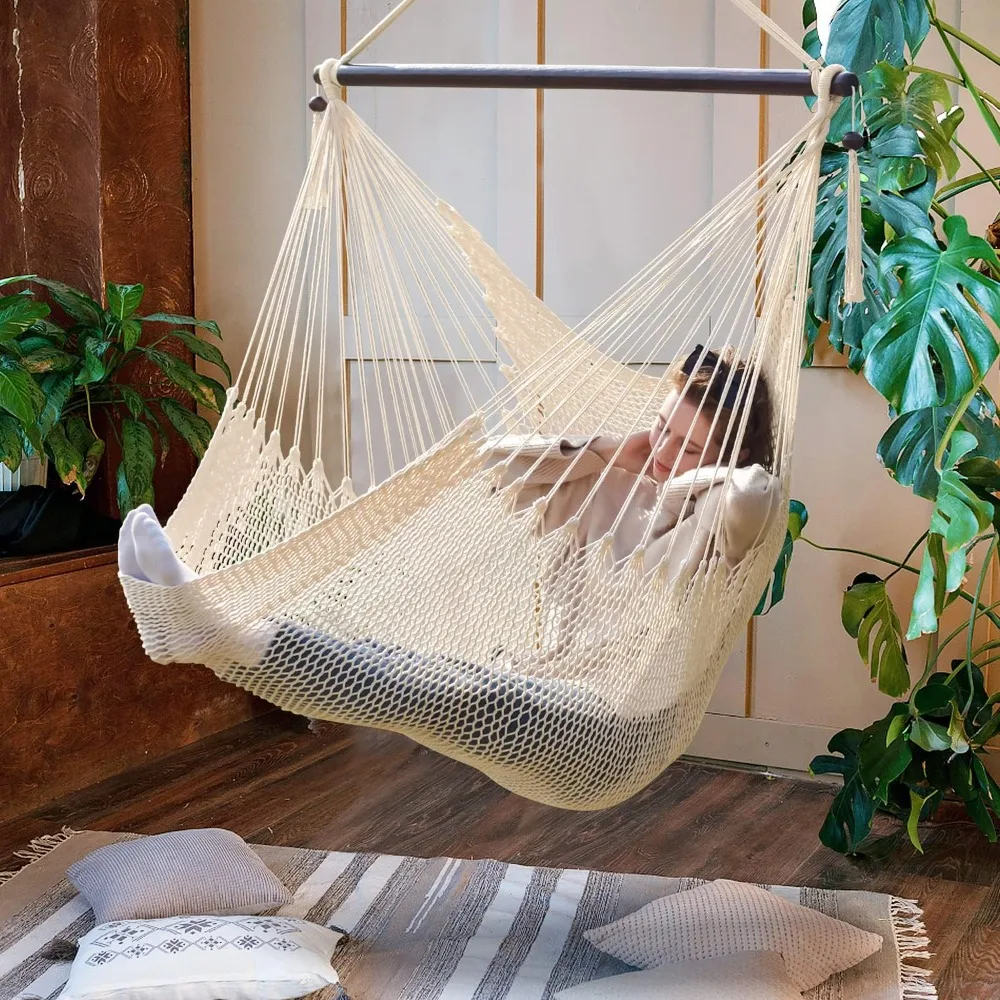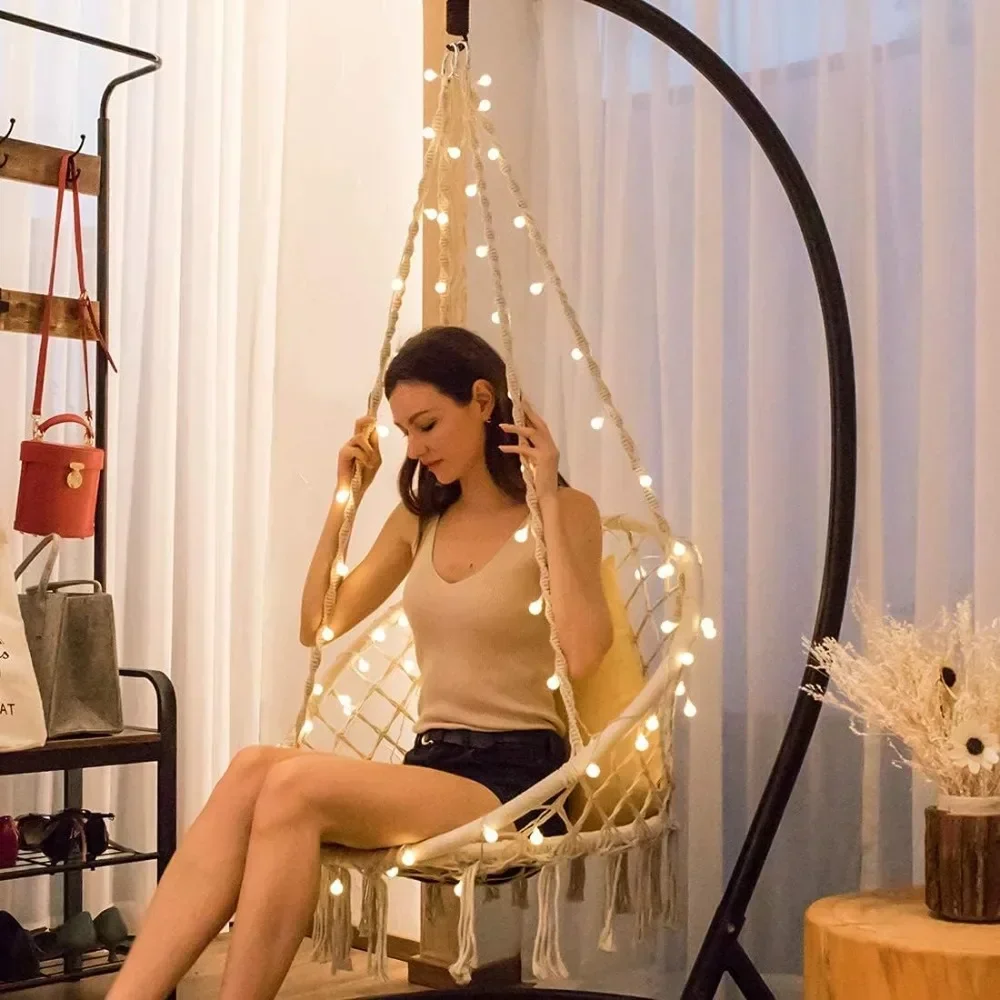Hammocks are often associated with lazy afternoons in the backyard or seaside relaxation, but did you know that you can enjoy the comfort and serenity of a hammock indoors? Hanging a hammock inside your home can provide a cozy, tranquil retreat perfect for reading, napping, or simply unwinding. This comprehensive guide, “How to Hang a Hammock Indoors: Tips for a Cozy Setup,” will walk you through the process, offering practical advice and creative ideas to help you create the perfect indoor hammock oasis.
Understanding the Benefits of Indoor Hammocks
Indoor hammocks offer numerous benefits that go beyond mere aesthetic appeal. Firstly, hammocks provide an unparalleled level of comfort. The cradling effect can significantly reduce pressure points and support a neutral spine position, making it a great option for relaxation and sleep. Numerous studies suggest that the gentle rocking motion of a hammock can even help improve sleep quality by facilitating quicker onset of sleep and deeper restorative rest.
Another significant benefit is the versatility of hammocks. Regardless of whether you live in a spacious house or a compact apartment, there is a hammock solution that can be customized to fit your living space. Hammocks are particularly useful in small apartments where they can serve as flexible seating or sleeping options without taking up valuable floor space. When not in use, hammocks can be easily taken down or pushed to one side, making them highly convenient.

Selecting the Right Hammock for Indoor Use
Choosing the perfect hammock for your indoor setup is crucial for both comfort and durability. The first thing to consider is the type of hammock that suits your needs. Traditional hammocks are made from materials such as cotton, canvas, or polyester. Cotton hammocks are soft and comfortable but might not be as durable as polyester or canvas options, which are designed to withstand more wear and tear.
Another popular choice for indoor use is the Brazilian or Mayan hammock, known for its tight weave and cocoon-like comfort. These hammocks are not stretched flat but cradle the body in a position that many find more comfortable for extended periods. Rope hammocks, while visually appealing, might not provide the same level of comfort unless properly cushioned with a hammock indoors.
Additionally, consider the size and weight capacity of the hammock. Some hammocks are designed for single-person use, while others can comfortably accommodate two people. Always check the weight limit to ensure it meets your requirements. Measurements are also important; ensure the hammock will fit the designated space indoors without being too tight or too loose.
Hammock chairs and swing chairs are excellent alternatives if you’re limited on space but still want the benefits of a hammock. These provide the same comfort and relaxation in a more compact, upright seating form.
Lastly, take into account the aesthetics. Hammocks come in various designs, from rustic, handwoven pieces to sleek, modern ones. Choose a style and color that complements your room’s decor to create a harmonious look.
Finding the Ideal Location for Your Indoor Hammock
The location you choose for hanging your indoor hammock is vital for both safety and comfort. First, identify a space that allows you to fully extend the hammock while ensuring that it’s clear of obstructions like furniture, windows, and doors. Bedrooms, living rooms, and sunrooms are popular choices, but you can get creative and find any cozy nook that fits the dimensions.
When considering the space needed, allow for at least two feet of clearance on either end of the hammock to account for swinging and getting in and out comfortably. Measure the distance between the two points where you plan to mount the hammock. This distance should be slightly longer than the length of the hammock when fully extended but not excessively so, as too much slack can affect the hammock’s comfort and stability.
Installing Your Hammock: Tools and Techniques
Installing a hammock indoors involves careful planning and the right tools to ensure a safe and secure setup. Essential tools you’ll need include a stud finder, measuring tape, drill, eye bolts or screw-in hooks, carabiners, and strong rope or hammock straps.
Step-by-Step Installation Guide
- Locate the Studs: Use a stud finder to locate studs in your walls or ceiling. Mark these locations with a pencil. Studs or joists should be the main anchor points as they provide the necessary support.
- Measure and Drill: Measure the distance between the studs to make sure it corresponds with your hammock’s length. Drill pilot holes at the marked spots to guide the eye bolts or hooks into place. Ensure these holes are slightly smaller than the diameter of your hooks for a snug fit.
- Install Eye Bolts or Hooks: Screw the eye bolts or hooks into the pilot holes securely. Use a wrench if necessary to ensure they’re tightly lodged in the stud or joist.
- Attach the Hammock: Use carabiners to clip the hammock to the eye bolts or hooks. If the hammock is slightly too short, you can use strong ropes or hammock straps to bridge the gap. Ensure these attachments are secure and can bear weight without slipping or coming loose.
- Test the Setup: Before fully committing to using your hammock, test it by applying gradual weight to ensure it’s securely installed and can support your intended load. Sit in the hammock gently and check for any signs of instability or weakness.

Enhancing Comfort: Accessories and Add-Ons
Once your hammock is securely installed, enhancing its comfort and aesthetic appeal with various accessories can create a truly inviting space. Pillows, cushions, and blankets can add a layer of coziness and support. Opt for weather-resistant fabrics if you expect the room to be humid, as they will be more durable and easier to clean.
A hammock indoors underquilt can provide added warmth in cooler climates, making your indoor hammock a year-round retreat. Overhead canopy attachments can give a unique touch, adding an element of privacy and coziness.
Consider adding a small side table or hanging pocket organizer for convenience. These can hold books, drinks, or electronic devices, making your hammock area a functional space for relaxation or work.
Lighting can also play a significant role in enhancing the ambiance. String lights, lanterns, or fairy lights can create a magical atmosphere, perfect for evening relaxation. Choose soft, warm lighting to maintain a calming environment.
Safety Considerations for Hanging an Indoor Hammock
While hammocks can be incredibly relaxing and enjoyable, safety is paramount when installing one indoors. Ensuring that your hammock is securely anchored and well-maintained is crucial to prevent accidents and injuries.
Anchoring and Installation Safety
The first and foremost safety consideration is properly securing the hammock. As mentioned earlier, always anchor your hammock to strong, load-bearing structures like ceiling joists or wall studs. Avoid using drywall anchors or similar fasteners, as they are not designed to support significant weight.
Check the eye bolts, hooks, and other hardware for weight ratings and ensure they are designed to support at least the maximum intended load, including any additional forces from movement and swinging. Use high-quality, durable rope or straps to secure the hammock, and inspect these materials regularly for wear and tear.

Regular Maintenance and Checks
Routine checks are essential for maintaining the safety of your indoor hammock. Inspect the hammock fabric for any signs of fraying or weakening, especially at the attachment points. Replace any worn-out parts immediately to prevent failure.
Regularly check the stability of the eye bolts or hooks, ensuring they remain tightly secured. Over time, vibrations and movement can loosen these components, so periodic tightening may be necessary.
Load Capacity
Always adhere to the manufacturer’s weight recommendations for both the hammock and the mounting hardware. Overloading can result in hardware failure and potential injury. Consider the weight of multiple users and additional items like pillows and blankets when calculating the total load.
Child and Pet Safety
If you have children or pets, ensure they understand how to use the hammock safely. Supervise young children when they use the hammock and teach them not to jump or swing excessively. For pets, monitor their interaction to prevent them from climbing or chewing on the hammock or its attachments.
Creative Ideas for Indoor Hammock Setups
The versatility of indoor hammocks allows for a range of creative setups that can transform any room into a cozy escape. Here are a few imaginative ideas to inspire your indoor hammock design:
Bohemian Retreat
Create a bohemian-style retreat with a macramé hammock, vibrant throw pillows, and textured blankets. Add elements like hanging plants, woven rugs, and colorful tapestries to complete the look. This setup creates a warm, inviting space that’s perfect for relaxation and meditation.
Minimalist Nook
For a minimalist approach, choose a sleek, single-color hammock to blend seamlessly with your décor. Pair it with a few carefully selected accessories like a simple side table and a modern reading lamp. This setup lends itself to a clean, uncluttered space that promotes calm and focus.
Reading Corner
Transform a corner of your room into a cozy reading nook with a hammock chair. Position a bookshelf or floating shelves nearby stocked with your favorite reads. Add a floor lamp or wall-mounted light for adequate reading lighting. This setup is perfect for book lovers looking for a peaceful spot to get lost in a good story.
Studio Sanctuary
In a studio apartment, use a hammock as both a seating and sleeping option to maximize space. Choose a sturdy, comfortable hammock that can be easily adjusted or taken down when not in use. Integrate storage solutions like under-bed drawers or wall-mounted shelves to keep the area tidy and functional.
Nature-Inspired Escape
Bring the outdoors in with a nature-inspired hammock setup. Use natural materials like a woven hammock, wooden furniture, and stone or clay accessories. Decorate with indoor plants and nature-inspired artworks to create a calming, earthy atmosphere that rejuvenates the spirit.
Concluding Thoughts: Embracing the Indoor Hammock Lifestyle
Hanging a hammock indoors offers a unique blend of comfort, relaxation, and style, transforming any space into a personal sanctuary. Whether you’re seeking a tranquil retreat, a functional seating area, or a creative corner, an indoor hammock can fulfill these desires while adding a touch of charm to your home.
Taking the time to choose the right hammock, finding the ideal location, ensuring secure installation, and adding personal touches can create a cozy and inviting setup. The versatility of hammocks means they can adapt to different styles, spaces, and uses, making them a valuable addition to any household.
